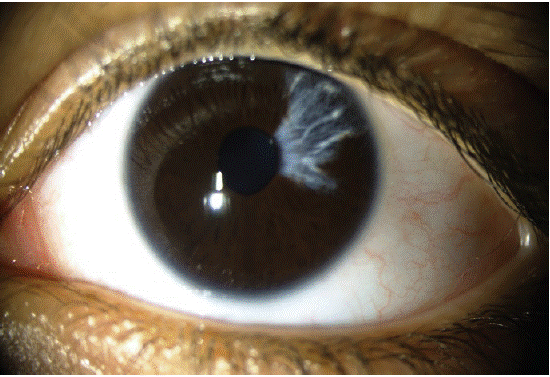
Clinical Image
Austin Ophthalmol. 2024; 8(2): 1063.
Bilateral Sutural Cataract in A Young Adult
Krichene MA*; Tebbay N; Hassina S; Akannour Y; Serghini L; Abdellah E
University Mohammed V Rabat-Morocco
*Corresponding author: Mohamed Amine Krichene University Mohammed V Rabat-Morocco. Email: drkrichene.m.amine@gmail.com
Received: March 25, 2024 Accepted: April 17, 2024 Published: April 24, 2024
Case Report
A 36-year-old woman, with no particular medical or ophthalmological history, presented for a change in her optical correction. She complains of a progressive decrease in vision over the past few months, with no ocular pain or redness. She has no family history of premature cataract.
Ophthalmological examination revealed a visual acuity of 7/10 in both eyes without correction, rising to 10/10 after refraction. Slit-lamp examination showed round, reactive pupils, with no anterior segment anomalies. After pupillary dilation, a sutural cataract appearance was observed in both eyes, characterized by radial linear opacities at the lens nucleus. The fundus is normal, with no signs of hypertension, diabetes or glaucoma.

Figure 1: Right eye.

Figure 2: Left eye.
The diagnosis of bilateral sutural cataract is made. This is a rare form of congenital cataract, linked to an anomaly in lens development. It may be isolated or associated with other ocular or systemic malformations. It generally manifests as a progressive loss of vision, which may be asymptomatic for a long time. Treatment is surgical, with removal of the opacified crystalline lens and implantation of an intraocular lens if uncorrectable visual acuity is reduced.
The interest of publishing this image is to share an unusual clinical case, which illustrates a rare cause of cataract in young adults. It also serves to raise awareness among ophthalmologists of the need to perform a fundus examination even in a simple correction consultation. Finally, it reminds us of the importance of looking for any associated anomalies, which can have an impact on visual prognosis and patient management.